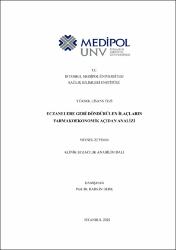| dc.contributor.advisor | Berk, Barkın | |
| dc.contributor.author | Zeydan, Veysel | |
| dc.date.accessioned | 2021-07-08T09:56:00Z | |
| dc.date.available | 2021-07-08T09:56:00Z | |
| dc.date.issued | 2019 | en_US |
| dc.date.submitted | 2019-08-05 | |
| dc.identifier.citation | Zeydan, V. (2019). Eczanelere geri döndürülen ilaçların farmakoekonomik açıdan analizi. (Yayınlanmamış yüksek lisans tezi). İstanbul Medipol Üniversitesi Sağlık Bilimleri Enstitüsü, İstanbul. | en_US |
| dc.identifier.uri | https://hdl.handle.net/20.500.12511/7535 | |
| dc.description.abstract | Ülkemizde dünyadakinin aksine yeniden kullanım potansiyeli olan ilaçların ne yapılacağı hakkında bir düzenleme henüz yoktur. Kontrolsüz yürütülen ilaç toplama faaliyetlerinin düzenli bir şekilde yürütülmesi için literatür ve mevzuat eksikliğinin olması ve ilgili konuda literatüre katkı amacıyla bu anket çalışmasına ihtiyaç duyulmuştur.Katılımcı eczacıların yaş ortalamasının 36,1±9,8 olduğu; %63'ünün erkek %37'sinin kadın olduğu; %65'inin İstanbul'da %35'inin İstanbul dışında mesleğini icra ettiği;13±9,1 yıl mesleki tecrübeye sahip olduğu ve bunun cinsiyete göre birbirinden farklı olduğu saptanmıştır.Kullanılmayan ilaçların toplanmasını organize edecek olan bir organizasyona destek verenler hem maddi hem de bizatihi destek verme isteğindedir. Eczanelerde miadı dolduğu için imha edilen ilaçlar nedeniyle yıllık ortalama 3397 TL mali kaybın olduğu,eczanelerde aylık ortalama 17kutu (561 TL) ilaç unutulduğu; evlerinde kullanılmayan ilaç sayısı ortalama 10,1±7,76 kutu; kullanımı bırakılan 6,2±6,11 (198±315,6 TL)kutu;miadı dolan ortalama kutu sayısının 2,9±4,67 olduğu, eczacıların %70'inin miadı dolan ilaçları kullandığı tespit edilmiştir.Eczacıların %68'inin bağış/hibe ilaç kabul ettiğini belirtmişken; %83'üne en az bir kere ilaç bağışının yapıldığıancak %92'sinin ceza almaktan çekindiği anlaşılmıştır.Son bir senede eczacı/eczanelerin miadı dolduğu için imha ettiği ilaçların kutu sayısıgruplara göre sırasıyla şu şekilde olmuştur: Antihipertansif, Antibiyotik, Analjezik, Antidepresan-antipsikotik, Diyabet ilaçları ilk 4 grup olup bunlarınçalışmanın %62'sini oluşturduğu saptanmıştır.Şu anda eczanenizde mevcut olan ve hastaların iade/bağış/hibe etmiş olduğu ilk üç grup ilacın etken maddesi/maddeleri sorusuna cevap olarak da toplamda 131 (53 farklı) etken madde belirtilmiştir.Sonuç olarak çalışmamız ilaç israfının büyük boyutlarda olduğunu ve eczacıların bu israfı azaltmak için maddi ve manevi destek vermeye hazır olduğunu göstermiştir. Kullanılmayan ilaçların tekrar ekonomiye kazandırılması organizasyonlarından uzak kalan eczacıların buna sebep olarak en fazla yürürlükteki mevzuatlardan şikayetçi oldukları görülmüştür. | en_US |
| dc.description.abstract | There is not any policy about what to do with the medicines that have the potential to be reused, opposite to the World. This survey was needed because of lacking literature which will decrease the waste of medicine for the process of gathering the medicines by the people who are not professional. It was found that the mean age of the pharmacist that took place in the survey was 36,1±9,8; 63% of them was male, while 37% was female; 65% of them were working İstanbul, while 35% were working out of İstanbul; mean years of working was 13±9,1 and this was different between genders. In other words, the pharmacists that give the medicines to an organization to gather the medicines support this process both financially and personally. The pharmacists have mean money waste per year 3397 TL and 17 (561 TL) boxes of medicines is forgotten in pharmacies per month. The mean boxes of the medicines that are not used at home is 10,1±7,76, the given up medicine at home is 6,2±6,1 the mean of the medicine boxes that have the expiration date were 2,9±4,67. 70% of the pharmacists use the medicines that reached the expiration date. 68% of the pharmacists accept charity medicine and 83% of them had at least once a charity medicine but 92% of them were afraid of being charged by healthauthorities. Because of reaching the expiration date, the extirpated medicine box number during the last year was respectively; antihypertensives, antibiotics, analgesics, antidepressants- antipsychotic, diabetes mellitus were the first 4 groups and formed 62 % of the study. The answer of the mostly taken 3 groups of medicine as charity in the pharmacies were 131 active ingredients and 53 of them were different. As a conclusion our research found that medicine waste is too much and the pharmacists are ready to decrease this waste both financially and personally. The reason for pharmacists not to take place in organizations that design the reuse of the medicines is mostly the laws. | en_US |
| dc.language.iso | tur | en_US |
| dc.publisher | İstanbul Medipol Üniversitesi Sağlık Bilimleri Enstitüsü | en_US |
| dc.rights | info:eu-repo/semantics/openAccess | en_US |
| dc.subject | Farmako-Ekonomi | en_US |
| dc.subject | İlaç Bağışı | en_US |
| dc.subject | Eczanelerdeki İlaç İsrafı | en_US |
| dc.subject | Pharmaco-Economy | en_US |
| dc.subject | Charity Medicine | en_US |
| dc.subject | Drug Waste in Pharmacies | en_US |
| dc.title | Eczanelere geri döndürülen ilaçların farmakoekonomik açıdan analizi | en_US |
| dc.title.alternative | Pharmacoeconomical analysis of the medicines that are returned to the pharmacies | en_US |
| dc.type | masterThesis | en_US |
| dc.department | İstanbul Medipol Üniversitesi, Sağlık Bilimleri Enstitüsü, Klinik Eczacılık Ana Bilim Dalı | en_US |
| dc.relation.publicationcategory | Tez | en_US |


















